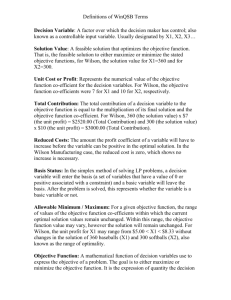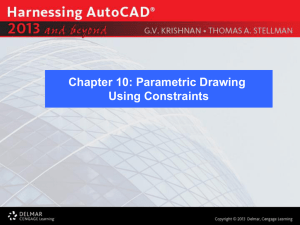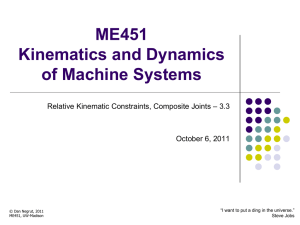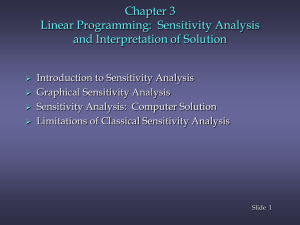SIE 340 Chapter 5. Sensitivity Analysis
advertisement
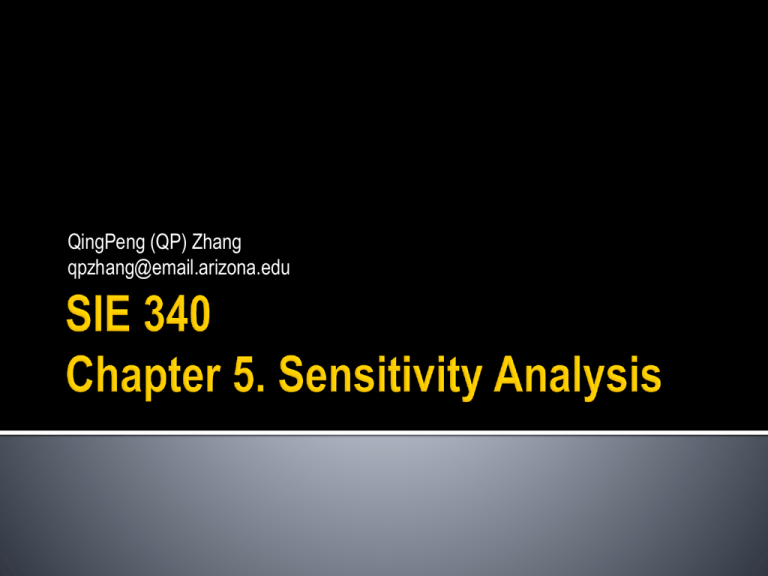
QingPeng (QP) Zhang qpzhang@email.arizona.edu Sensitivity analysis is concerned with how changes in an linear programming’s parameters affect the optimal solution. Weekly profit (revenue - costs) Profit generated by each soldier $3 Profit generated by each train $2 𝑥1 = number of soldiers produced each week 𝑥2 = number of trains produced each week. max 𝑧 = 3𝑥1 + 2𝑥2 (weekly profit) s.t. 2𝑥1 + 𝑥2 ≤ 100 (finishing constraint) 𝑥1 + 𝑥2 ≤ 80 (carpentry constraint) 𝑥1 ≤ 40 (demand constraint) 𝑥1 , 𝑥2 ≥ 0 (sign restriction) 𝑥1 = number of soldiers produced each week 𝑥2 = number of trains produced each week. Constraint/Objective Slope Finishing constraint -2 Carpentry constraint -1.5 Objective function -1 Optimal solution (𝑥1 , 𝑥2 )=(60, 180) 𝑧=180 Basic variable Basic solution Change objective function coefficient Change right-hand side of constraint Other change options Shadow price The Importance of sensitivity analysis How would changes in the problem’s objective function coefficients or the constraint’s right-hand sides change this optimal solution? max 𝑧 = 3𝑥1 + 2𝑥2 𝑐1 𝑧 = 𝑐1 𝑥1 + 2𝑥2 𝑐1 1 𝑥2 = − + 𝑧 2 2 𝑐1 − 2 < ? −2 𝑐1 − 2 > ? −1 𝑐1 1 𝑥2 = − + 𝑧 2 2 If 𝑐1 − 2 then 𝑐1 2 < −2 >2 Slope is steeper B->C 𝑐1 1 𝑥2 = − + 𝑧 2 2 Slope is steeper New optimal solution: (40, 20) 𝑧 = 𝑐1 × 40 + 2 × 20 𝑐1 1 𝑥2 = − + 𝑧 2 2 If 𝑐1 − 2 then 𝑐1 2 > −1 <1 Slope is flatter B->A 𝑐1 1 𝑥2 = − + 𝑧 2 2 Slope is steeper New optimal solution: (0, 80) z=2 × 80 = 160 Change objective function coefficient Change right-hand side of constraint Other change options Shadow price The Importance of sensitivity analysis 𝑏1 max 𝑧 = 3𝑥1 + 2𝑥2 (weekly profit) s.t. 2𝑥1 + 𝑥2 ≤ 100 (finishing constraint) 𝑥1 + 𝑥2 ≤ 80 (carpentry constraint) 𝑥1 ≤ 40 (demand constraint) 𝑥1 , 𝑥2 ≥ 0 (sign restriction) 𝑥1 = number of soldiers produced each week 𝑥2 = number of trains produced each week. 𝑏1 is the number of finishing hours. Change in b1 shifts the finishing constraint parallel to its current position. Current optimal point (B) is where the carpentry and finishing constraints are binding. As long as the binding point (B) of finishing and carpentry constraints is feasible, optimal solution will occur at the binding point. 𝑥1 ≤ 40 𝑥1 , 𝑥2 ≥ 0 If 𝑏1 >120, 𝑥1 >40 at the binding point. If 𝑏1 <80, 𝑥1 <0 at the binding point. So, in order to keep the basic solution, we need: 80 ≤ 𝑏1 ≤ 120 (z is changed) (demand constraint) (sign restriction) Change objective function coefficient Change right-hand side of constraint Other change options Shadow price The Importance of sensitivity analysis max 𝑧 = 3𝑥1 + 2𝑥2 (weekly profit) s.t. 2𝑥1 + 𝑥2 ≤ 100 (finishing constraint) 𝑥1 + 𝑥2 ≤ 80 (carpentry constraint) 𝑥1 ≤ 40 (demand constraint) 𝑥1 , 𝑥2 ≥ 0 (sign restriction) 2 1 1 1 1 0 max 𝑧 = 3𝑥1 + 2𝑥2 (weekly profit) s.t. 2𝑥1 + 𝑥2 ≤ 100 (finishing constraint) 𝑥1 + 𝑥2 ≤ 80 (carpentry constraint) 𝑥1 ≤ 40 (demand constraint) 𝑥1 , 𝑥2 ≥ 0 (sign restriction) Change objective function coefficient Change right-hand side of constraint Other change options Shadow price The Importance of sensitivity analysis To determine how a constraint’s rhs changes the optimal z-value. The shadow price for the ith constraint of an LP is the amount by which the optimal z-value is improved (increased in a max problem or decreased in a min problem). Finishing constraint Basic variable: 100 Current value 𝑏1 =100+Δ New optimal solution (20+Δ, 60-Δ) z=3𝑥1 +2𝑥2 =180+ Δ Current basis is optimal one increase in finishing hours increase optimal z-value by $1 The shadow price for the finishing constraint is $1 Change objective function coefficient Change right-hand side of constraint Other change options Shadow price The Importance of sensitivity analysis If LP parameters change, whether we have to solve the problem again? In previous example: sensitivity analysis shows it is unnecessary as long as: 80 ≤ 𝑏1 ≤ 120 z is changed Deal with the uncertainty about LP parameters • Example: • The weekly demand for soldiers is 40. • Optimal solution B • If the weekly demand is uncertain. 𝑥1 ≤? • As long as the demand is at least 20, B is still the optimal solution.


